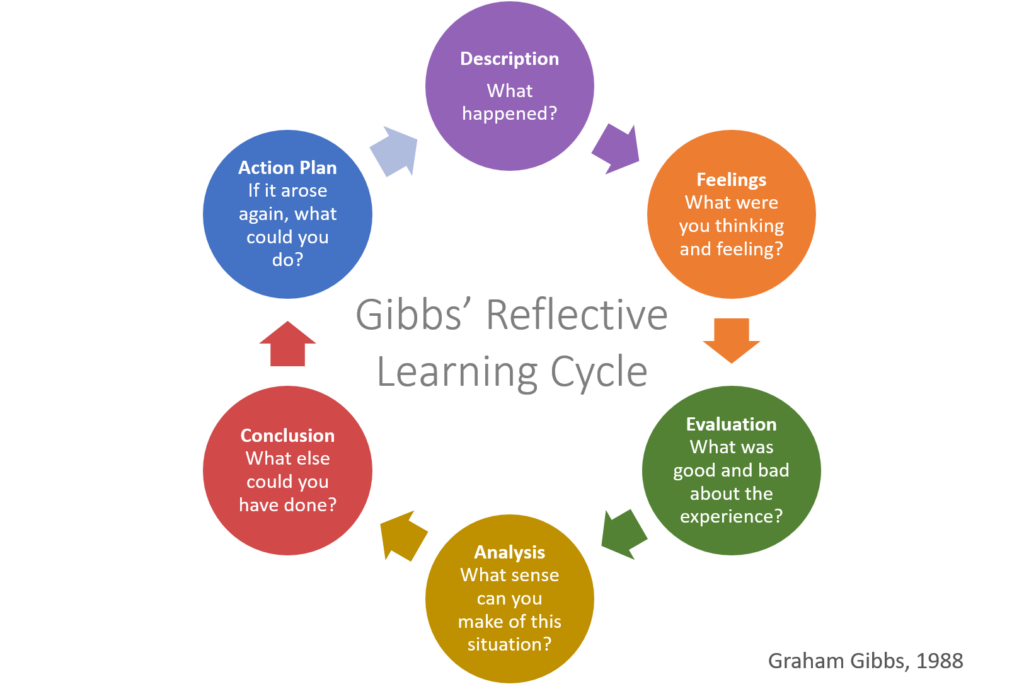(Response to prompt #1: Use Gibbs’ Reflective Cycle to discuss your in-situ at Marysville Elementary School this week)

Image from https://helendenheld.com/tag/gibbs-reflective-learning-cycle/
The Gibbs Reflective Cycle is a new idea to me, but I found it really helpful when looking back on my in-situ lesson this week. Honestly, I think I’ll print out a copy of the graphic above to reflect on in the future! I could see this method of reflection working well for social emotional situations as well as academic ones.
For this week’s lesson we created stop-motion videos with two grade 3 classes, and I’m going to outline each point in the Gibbs Reflective Cycle as it fits with my in-situ experience.
Description: What happened?
-My year two cohort visited a K-3 Elementary school in the area for an in-situ technology lesson. We introduced ourselves to the two grade 3 classes we were partnered with, then split into teaching pairs and each worked with a group of about 5 students. The students had already learned about using the Zing! Studios app, so when it came to creating the stop motion films they were very confident. The students used their “desk pets” (tiny stuffed animals) as the actors, and created props, backdrops, and a storyline in collaboration with the teaching pairs. When the filming was complete, the students edited, added sound effects, and then shared their creations with the class in a “movie premiere”.
Feelings: What were you thinking and feeling?
I felt so happy to be working in a classroom for this lesson, and I was thrilled that the students were just as excited to create stop motion videos as I was. At first I was nervous to be in a classroom while sick because I was starting to lose my voice, but for this lesson it wasn’t an issue and the students could understand me well. I felt very curious about how K-3 schools work, because before the lesson I actually did not know they existed (embarrassing, right?).
Evaluation: What was good and bad about the experience?
I’ll get the bad out of the way first because it’s pretty quick. In fact, it’s more like “slight room for improvement” than bad. The students enjoyed the lesson so much, I wish they had more time to work on their videos. My group of students had so many ideas about story elements, backgrounds, sound effects, and prop designs that I think it would be great to see them have two classes to fully realize these ideas. In a way that is also the good part- that students were so creative, collaborative, and joyful in this lesson, it really reminded me how amazing kids are and why I want to teach them.
Analysis: What sense can you make of the situation?
I think this wonderful lesson represents many classrooms, but I also have to remember that sometimes things don’t work so smoothly and that’s ok. I think many factors contributed to the success of the lesson, and those factors are not a given in elementary schools. For example, the two classes were grade 3 within a K-3 school, so their way of being probably reflects the responsibility they feel as the oldest students in their school. The two classes were also quite used to the team teaching approach, as were there respective teachers. I think this made collaboration extra smooth, and perhaps even prepared students for staying regulated in large groups of people. I also know from experience that students may act very differently in front of new guests, based on the time of day, and based on all the complex factors in their personal lives that allow them to regulate and learn more easily.
Conclusion: What else could you have done?
I think that I could’ve been more direct in helping the student group with time management. Even though the video came together in the end and the group was proud of their work, the storyboard portion of the lesson took up a bit more time than the budget allowed for. Shortening the group’s storyboard session would’ve allowed them for more time to create props, which they were very excited about but didn’t get much time to do. I also think I could’ve had a quick huddle with my teaching partner before starting the lesson to make sure we were on the same page about divvying up the talking portions, because I worry that I may have used up too much of the air time.
Action plan: If it arose again, what could you do?
If (or more accurately, when) a similar teaching scenario arises, I want to ensure I budget well for time and am not dominating the teaching/learning conversation. I have a personal time-budgeting method I use for essay writing, where I will write down on a paper the amounts of time each portion will take and then move to the next portion as each time stamp passes on the clock, crossing them off as I go. I think something similar to this would be worth a try in the classroom. As I said in the previous paragraph, I would also like to have a 30 second chat with my teaching partner before starting to make a game plan for delivering the lesson as a team.

Hi Graham,
I really enjoyed this experience too. I agree, that activity was fun, but could be more effective if the activities were broken down and allowed the students more time for planning each section.